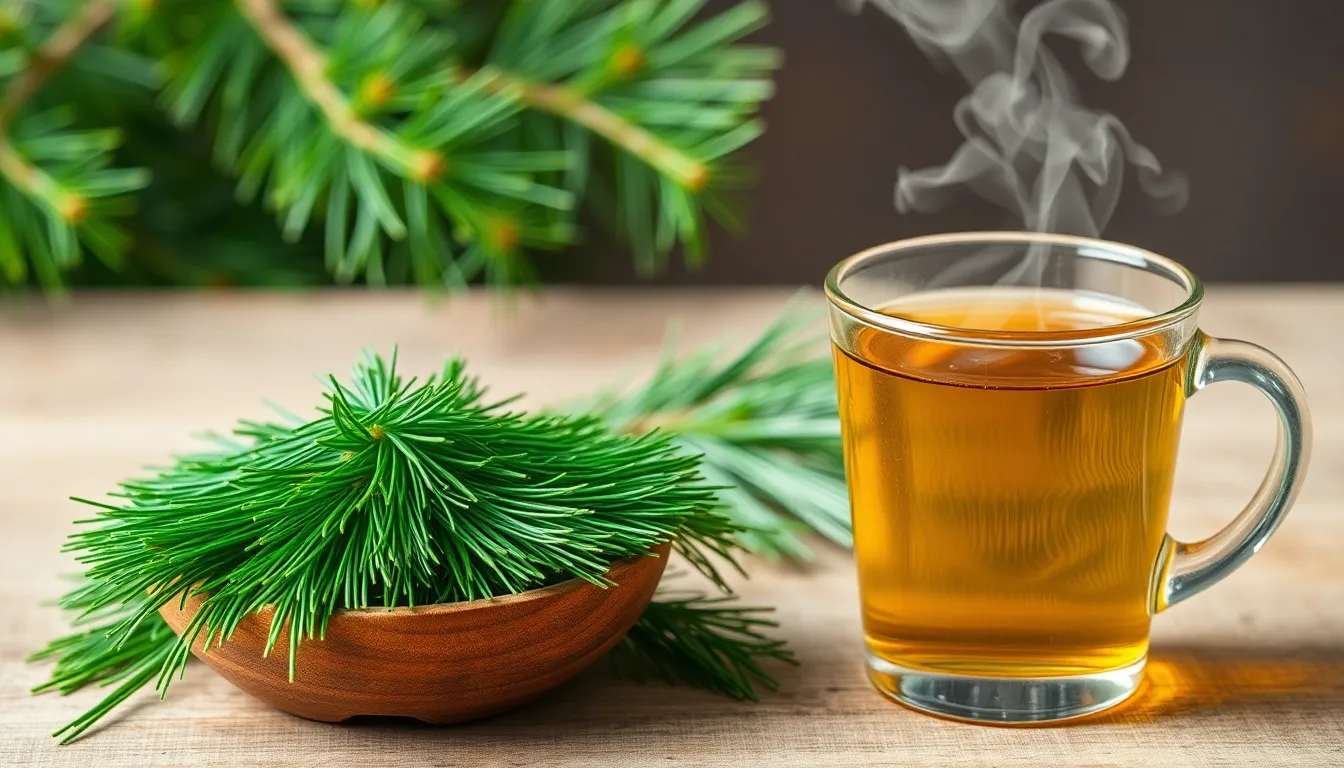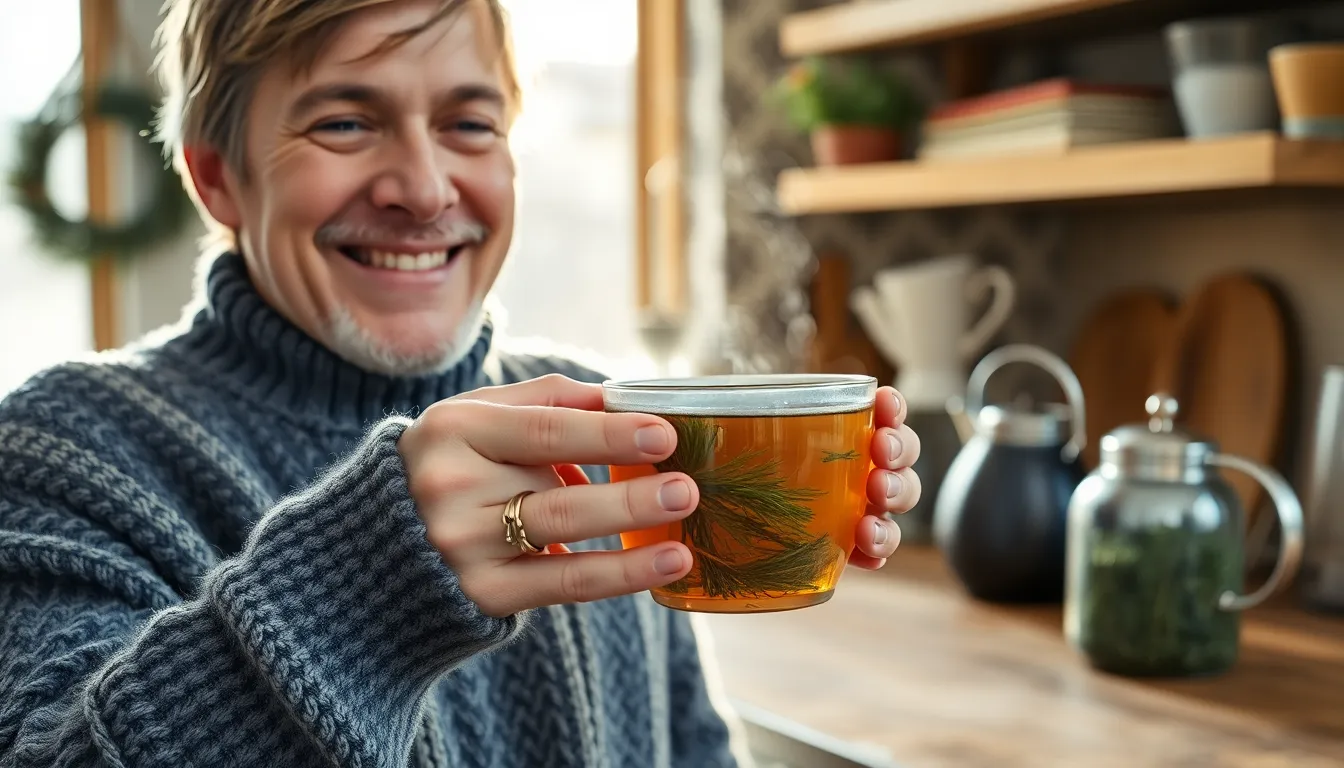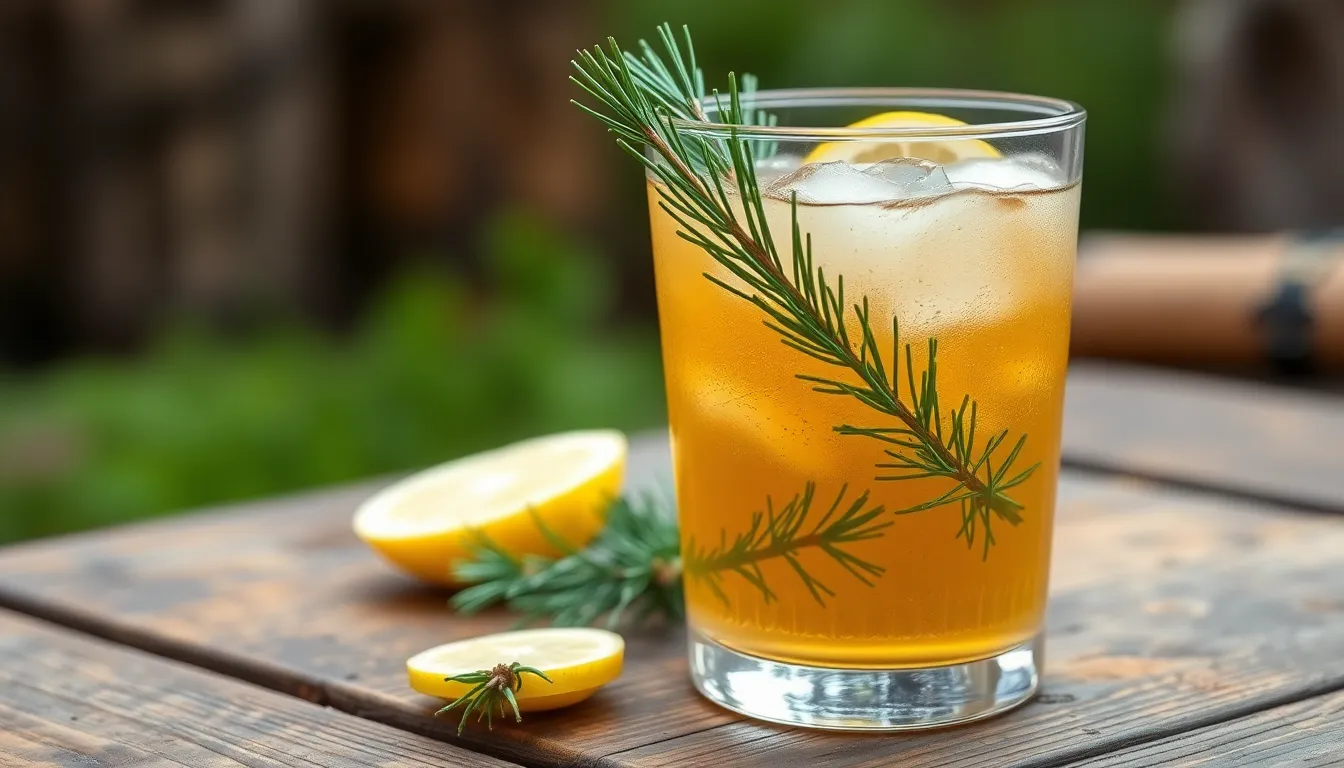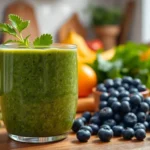We’ve discovered nature’s most surprising winter wellness secret hiding right in our backyards – pine needle tea. This ancient remedy has been treasured by indigenous cultures for centuries as a powerhouse of vitamin C and natural antioxidants that can boost immunity and fight off seasonal ailments.
Fresh pine needles create a refreshing citrusy brew that’s surprisingly delicious and incredibly easy to make. With just a handful of clean needles and hot water we can transform these evergreen treasures into a therapeutic drink that tastes like a forest walk in a cup.
What makes pine needle tea truly special is its incredible nutritional profile – it contains more vitamin C than most citrus fruits and offers natural compounds that support respiratory health. We’ll show you exactly which pine varieties are safe to use and how to brew the perfect cup that’ll become your new favorite winter ritual.
What You’ll Need
Making pine needle tea requires minimal supplies but careful attention to pine variety selection. We’ll guide you through choosing the right needles and gathering essential brewing equipment.
Pine Needle Selection
We recommend using needles from white pine, Douglas fir, or spruce trees for the safest and most flavorful tea. Fresh young needles from branch tips provide the highest vitamin C content and deliver the most vibrant taste.
Safe Pine Varieties:
- White pine (Pinus strobus)
- Eastern white pine
- Douglas fir (Pseudotsuga menziesii)
- Blue spruce (Picea pungens)
- Norway spruce (Picea abies)
Avoid These Toxic Varieties:
- Yew (Taxus species)
- Norfolk Island pine
- Ponderosa pine
- Lodgepole pine
We suggest harvesting 1-2 tablespoons of needles per cup of tea you plan to brew. Look for bright green needles without brown spots or signs of disease. Fresh needles should feel pliable and release a pleasant pine fragrance when gently crushed.
Essential Equipment
We need only basic kitchen tools to create this nourishing beverage. Standard brewing equipment works perfectly for extracting pine needle nutrients and flavors.
Required Items:
- Tea kettle or saucepan for heating water
- Fine mesh strainer or cheesecloth
- Tea cups or mugs
- Sharp kitchen scissors or pruning shears
- Cutting board for needle preparation
Optional Enhancements:
- Tea infuser basket for easy removal
- Honey or maple syrup for natural sweetening
- Lemon slices for additional vitamin C
- Thermos for storing brewed tea
We recommend using filtered water to avoid chlorine interference with the delicate pine flavors. Glass or ceramic containers preserve the tea’s natural taste better than metal options.
Ingredients

We need just a few simple ingredients to create this nutritious pine needle tea. The quality of our ingredients directly impacts both the flavor and health benefits of the final brew.
Fresh Pine Needles form the foundation of our tea. We recommend using 2-3 tablespoons of fresh needles or 1 tablespoon of dried needles per cup of water. Eastern White Pine needles provide the mildest flavor and highest vitamin C content. Fresh young needles from branch tips deliver the most potent nutritional benefits and aromatic compounds.
Filtered Water serves as our brewing base. We use 8 ounces of water per serving to extract the optimal concentration of vitamins and antioxidants from the pine needles. Quality water enhances the tea’s natural citrus and pine notes without introducing unwanted minerals or chemicals.
Optional Flavor Enhancers allow us to customize our tea experience:
- Honey adds natural sweetness and complements the tea’s earthy profile
- Fresh Lemon Slice brightens the flavor while boosting vitamin C content
- Chamomile creates a calming blend when combined with pine needles
- Fresh Mint provides a refreshing twist to the traditional recipe
- Sage adds herbal complexity and additional health benefits
| Ingredient | Amount per Serving | Purpose |
|---|---|---|
| Fresh Pine Needles | 2-3 tablespoons | Primary flavor and nutrients |
| Dried Pine Needles | 1 tablespoon | Alternative to fresh needles |
| Filtered Water | 8 ounces | Brewing liquid |
| Honey | 1 teaspoon | Optional sweetener |
| Lemon Slice | 1 slice | Optional flavor enhancer |
The pine needles should appear bright green and emit a fresh, resinous aroma when crushed. We avoid any needles that look brown or wilted as these may have lost their nutritional potency. Properly selected ingredients ensure our pine needle tea delivers maximum vitamin A and vitamin C content along with powerful antioxidants.
Instructions

Follow these simple steps to brew your perfect cup of pine needle tea. Our method ensures maximum nutrient extraction while creating a flavorful and therapeutic beverage.
Prep the Pine Needles
We start by carefully examining our pine needles to ensure we have an edible species like white pine with its distinctive clusters of five needles. Gather a handful of fresh needles from the tips of branches where the vitamin C concentration is highest. Cut the needles into smaller pieces if desired though whole needles work perfectly fine for brewing. Rinse the needles gently under cool running water to remove any debris or dust that may have accumulated on the surface.
Boil the Water
Heat your filtered water in a kettle or saucepan until it reaches a near boil or gentle boil. We must be cautious not to use water that’s too hot as excessive heat can destroy the delicate nutrients we’re trying to extract. The ideal temperature should be just below a rolling boil to preserve the vitamin C and other beneficial compounds in the pine needles.
Steep the Tea
Add the prepared pine needles to your hot water and allow them to steep for approximately 10 minutes for a mild tea. For those who prefer a stronger flavor we recommend steeping the needles overnight which will create a more robust and concentrated brew. Cover the tea container while steeping to prevent the essential oils from escaping and to achieve the best possible results. The longer steeping time allows more nutrients to be extracted from the needles.
Strain and Serve
Remove all pine needles from the tea using a fine mesh strainer to ensure a smooth drinking experience. Pour the strained tea into your favorite mug and enjoy it as is or enhance the flavor with honey or fresh lemon slices. The tea can be served hot immediately or stored in a thermos to maintain temperature throughout the day. We find that adding a teaspoon of honey not only sweetens the tea but also provides additional immune supporting benefits.
Directions for Hot Pine Needle Tea

We begin by gathering our cleaned pine needles and setting up our brewing station with all necessary equipment within easy reach. Our first step involves placing the rinsed pine needles in a heat-resistant glass jar or teapot, ensuring we use the proper ratio of 2-3 tablespoons of fresh needles per cup of water.
Next, we heat our filtered water in a kettle until it reaches just below boiling point, around 190-200°F. We want to avoid a full rolling boil as excessive heat can destroy the delicate vitamin C content that makes this tea so beneficial for our immune system.
Once our water reaches the optimal temperature, we pour it directly over the pine needles in our container. The aromatic pine scent should immediately fill the air as the hot water begins extracting the nutrients from the needles.
We cover our brewing vessel immediately to trap the essential oils and prevent them from escaping with the steam. This step proves crucial for maintaining the tea’s therapeutic properties and ensuring we capture all the anti-inflammatory compounds.
Our steeping time depends on the desired strength we prefer. We allow the mixture to infuse for 10 minutes for a mild, refreshing flavor that newcomers often appreciate. Those seeking stronger medicinal benefits can extend the steeping time up to 20 minutes for a more robust brew.
After our chosen steeping period, we strain the tea through a fine mesh strainer or cheesecloth to remove all needle particles. We press the needles gently against the strainer to extract any remaining liquid without forcing bitter compounds into our final brew.
We serve the tea immediately while hot, adding honey or lemon to taste if desired. The natural pine flavor offers a refreshing earthiness that many find surprisingly pleasant and energizing.
For those preparing multiple servings, we can multiply our recipe accordingly and store any extra tea in a thermos to maintain temperature and enjoy throughout the day.
Directions for Iced Pine Needle Tea

Making iced pine needle tea transforms this warming winter beverage into a refreshing cold drink perfect for any season. We’ll guide you through the simple process of creating this vitamin C-rich refreshment that maintains all the health benefits of its hot counterpart.
Step 1: Prepare the Pine Needles
Start by gathering 2-3 tablespoons of fresh pine needles from a safe variety such as Eastern White Pine or Douglas Fir. Rinse the needles thoroughly under cold running water to remove any dust or debris. Pat them dry with a clean kitchen towel and roughly chop them to release more of their beneficial compounds during steeping.
Step 2: Brew the Tea Base
Bring 2 cups of filtered water to just below a rolling boil in your tea kettle. Remove from heat and add the prepared pine needles to the hot water. Cover the container immediately to prevent the essential oils from escaping. Allow the mixture to steep for 10-15 minutes for optimal flavor extraction and maximum vitamin C content.
Step 3: Strain and Cool
Pour the steeped tea through a fine mesh strainer to remove all pine needle particles. Discard the used needles and let the liquid cool to room temperature. This cooling process typically takes 30-45 minutes depending on your kitchen temperature.
Step 4: Chill and Serve
Transfer the cooled tea to your refrigerator and chill for at least 2 hours until thoroughly cold. Fill glasses with ice cubes and pour the chilled pine needle tea over the ice. Add honey or fresh lemon juice to taste if desired. The iced tea will keep in the refrigerator for up to 3 days when stored in a covered container.
Serving Variations
We recommend serving this antioxidant-rich beverage in tall glasses garnished with a sprig of fresh pine needles or a lemon wheel. For enhanced flavor complexity, consider adding fresh mint leaves or a few drops of vanilla extract to each glass before serving.
Storage Instructions

Proper storage extends the life of our pine needle tea ingredients and preserves their nutritional benefits. We can maintain freshness and potency by following these proven storage methods.
Storing Fresh Pine Needles
Fresh pine needles require careful handling to maintain their vitamin C content and essential oils. We recommend storing them in the refrigerator for up to 7 days when placed in a breathable container or paper bag.
For extended storage we can freeze fresh pine needles in airtight freezer-safe bags for up to one year. This method preserves both flavor and nutrients effectively. The freezing process actually breaks down cell walls slightly making the nutrients more accessible during brewing.
| Storage Method | Duration | Container Type |
|---|---|---|
| Refrigeration | 7 days | Breathable container or paper bag |
| Freezing | 1 year | Airtight freezer-safe bag |
| Cool dry place | 3-5 days | Ventilated container |
When refrigeration isn’t available we can store pine needles in a cool dry place away from direct sunlight and heat sources. This method works best for short-term storage of 3-5 days. Always keep needles away from moisture to prevent spoilage and mold growth.
Storing Prepared Tea
Brewed pine needle tea maintains its beneficial properties when stored correctly. We can refrigerate leftover tea in an airtight container for up to 30 days or freeze it for longer storage periods.
Before storing prepared tea we should allow it to cool completely at room temperature. Glass containers work best as they don’t absorb flavors or odors that might affect the tea’s taste.
For tea leaves that we plan to dry and reuse we can air-dry them for 20-30 minutes on a clean towel before placing them in an airtight container. Dried tea leaves should be stored in a dark cool area to maintain their flavor compounds and prevent degradation from light exposure.
Large batches of prepared tea can be portioned into ice cube trays and frozen for convenient single servings. These frozen tea cubes dissolve quickly in hot water and retain most of their original nutritional value.
Safety Tips and Considerations

Species identification stands as the most critical safety factor when harvesting pine needles for tea. We recommend using Eastern white pine (Pinus strobus), Japanese red pine (Pinus densiflora), and certain firs and spruces as these varieties are safe for consumption. Always verify the exact species before harvesting, as some evergreens contain toxic compounds that can cause serious health issues.
Avoid these dangerous varieties entirely: yew, Norfolk Island pine, and Ponderosa pine. These species contain harmful substances that make them unsuitable for tea preparation. When in doubt about tree identification, consult with a local botanist or forestry expert before collecting any needles.
Harvesting location plays a crucial role in tea safety. We select needles from trees located away from roads, industrial areas, and polluted environments to minimize exposure to contaminants. Fresh, bright green needles provide the best flavor and nutritional value, while brown or yellowing needles should be discarded as they offer less nutritional benefit and may taste unpleasant.
Proper brewing technique preserves both safety and nutrients. We pour boiling water over the needles rather than boiling them directly, which helps maintain the delicate compounds and prevents the release of potentially harmful substances. This method also ensures optimal flavor extraction while protecting beneficial nutrients.
Potential side effects require awareness and monitoring. Some individuals may experience nausea, headaches, or skin irritation when consuming pine needle tea. Allergic reactions, though rare, can include hives or respiratory issues. People with known pine allergies should avoid this beverage completely.
Pregnancy presents exact risks that demand strict avoidance. Pine needle tea contains compounds that may stimulate uterine contractions, potentially leading to miscarriage or preterm labor. Pregnant women should never consume this tea regardless of the pine species used.
Medical consultation provides essential guidance for regular consumption. We strongly recommend consulting with a healthcare professional before incorporating pine needle tea into your regular diet, especially if you have pre-existing medical conditions or take medications. This precaution helps prevent potential interactions and ensures the tea complements your overall health plan.
Start with small amounts when trying pine needle tea for the first time. This approach allows you to monitor your body’s response and identify any adverse reactions before consuming larger quantities. Discontinue use immediately if you experience any uncomfortable symptoms.
Flavor Variations

We can transform our basic pine needle tea into delicious variations that enhance both taste and wellness benefits. These simple additions create unique flavor profiles while maintaining the tea’s natural therapeutic properties.
Honey Sweetened Pine Needle Tea
Raw honey makes an excellent complement to pine needle tea’s natural resinous flavor. We add 1-2 teaspoons of honey per cup after the steeping process to preserve the honey’s beneficial enzymes and create a gentle sweetness that balances the tea’s mild bitterness.
This variation works particularly well for soothing sore throats during winter months. Local honey varieties provide additional benefits while creating different flavor notes. We recommend starting with clover or wildflower honey for a mild sweetness that won’t overpower the pine’s forest-like taste.
Citrus Pine Needle Tea
Fresh citrus brightens our pine needle tea with tangy undertones that enhance the natural piney notes. We add thin slices of lemon, lime, or orange either during the final 2-3 minutes of steeping or directly to the finished tea.
The key to preserving both citrus and needle flavors lies in water temperature control. We cool our boiled water slightly to 180-190°F before pouring over the pine needles and citrus. This gentler heat extracts optimal flavors without destroying delicate vitamin C compounds.
Orange slices create a sweeter profile while lemon provides classic tartness. Lime offers a unique tropical twist that pairs surprisingly well with the evergreen essence.
Spiced Pine Needle Tea
Warming spices transform our pine needle tea into a comforting winter beverage with complex flavors. We add whole spices during the steeping process to infuse the tea with aromatic compounds that complement the resinous pine taste.
Popular spice combinations include cinnamon sticks and whole cloves for a festive flavor, fresh ginger slices for warming heat, or star anise for subtle licorice notes. We typically use one cinnamon stick, 3-4 whole cloves, or a 1-inch piece of fresh ginger per 2 cups of tea.
These spices create depth and warmth that makes pine needle tea perfect for cold weather enjoyment. The aromatic oils from whole spices provide better flavor integration than ground alternatives while avoiding sediment in the finished tea.
Conclusion
Pine needle tea offers us a natural and accessible way to boost our winter wellness routine. We’ve discovered that this ancient remedy provides exceptional vitamin C content and antioxidant benefits while being surprisingly simple to prepare at home.
The versatility of pine needle tea makes it perfect for any season – whether we’re sipping it hot during cold months or enjoying it iced in warmer weather. With proper species identification and safe harvesting practices we can confidently incorporate this therapeutic beverage into our daily lives.
Remember to start with small amounts and consult healthcare professionals if you’re pregnant or have exact health concerns. By following our storage tips and experimenting with different flavor combinations we can maximize both the health benefits and enjoyment of this remarkable forest-to-cup experience.
Frequently Asked Questions
What is pine needle tea and why should I drink it?
Pine needle tea is a natural beverage made from fresh or dried pine needles that’s rich in vitamin C and antioxidants. It offers exceptional immune support, containing more vitamin C than most citrus fruits, making it perfect for combating seasonal illnesses and supporting respiratory health during winter months.
Which pine varieties are safe for making tea?
Safe varieties include Eastern White Pine, Douglas Fir, and certain spruce trees. Always use needles from white pine, Douglas fir, or spruce for the safest and most flavorful tea. Avoid toxic varieties like yew, Norfolk Island pine, and Ponderosa pine, which can be harmful.
How do I prepare pine needles for tea?
Use 2-3 tablespoons of fresh pine needles or 1 tablespoon dried needles per cup of filtered water. Choose young needles from branch tips for maximum vitamin C content. Rinse needles thoroughly before use and ensure they’re from edible species.
What’s the proper brewing method for pine needle tea?
Heat filtered water to just below boiling to preserve nutrients. Steep pine needles for 10 minutes for mild flavor or up to 20 minutes for stronger brew. Cover the container to retain essential oils, then strain before serving. Add honey or lemon to taste.
How long can I store pine needle tea and ingredients?
Fresh pine needles last 7 days refrigerated in breathable containers or freeze for up to one year. Brewed tea stays fresh in the refrigerator for up to 30 days in airtight containers or can be frozen for longer storage using ice cube trays.
Are there any safety concerns with pine needle tea?
Yes, proper species identification is crucial. Avoid harvesting near roads or polluted areas. Some people may experience allergic reactions, and pregnant women should consult healthcare professionals before consumption. Start with small amounts to monitor your body’s response to the tea.
Can I make iced pine needle tea?
Absolutely! Brew the tea using the standard hot method, then cool and chill before serving over ice. The iced version maintains all health benefits and stays fresh for up to three days refrigerated. Garnish with fresh pine needles or lemon wheels for enhanced presentation.
What flavor variations can I try with pine needle tea?
Enhance your tea with raw honey for sweetness, fresh citrus slices for tanginess, or warming spices like cinnamon and ginger. You can also add chamomile, fresh mint, sage, or vanilla extract to create unique flavor profiles while maintaining therapeutic properties.







